UK vs India Higher Education Systems: Comparative Analysis & Changes
VerifiedAdded on 2023/04/07
|10
|2702
|433
Essay
AI Summary
This essay critically evaluates and enumerates the differences between the higher education systems of the United Kingdom and India. It highlights the strengths of the UK system, including its diverse options, high employability of graduates, English language immersion, scholarship opportunities, multicultural environment, flexible work options, and strong research support. The essay also discusses the Indian education system, acknowledging its large scale and prestigious institutions like IIT and IIM, but also pointing out challenges such as poverty, income inequality, family pressure, and government intervention. The author suggests improvements for the Indian system, including reduced government intervention, increased awareness of career options, and greater support for underprivileged students, to bring it on par with international standards. The document is contributed by a student and available on Desklib, a platform providing study tools for students.
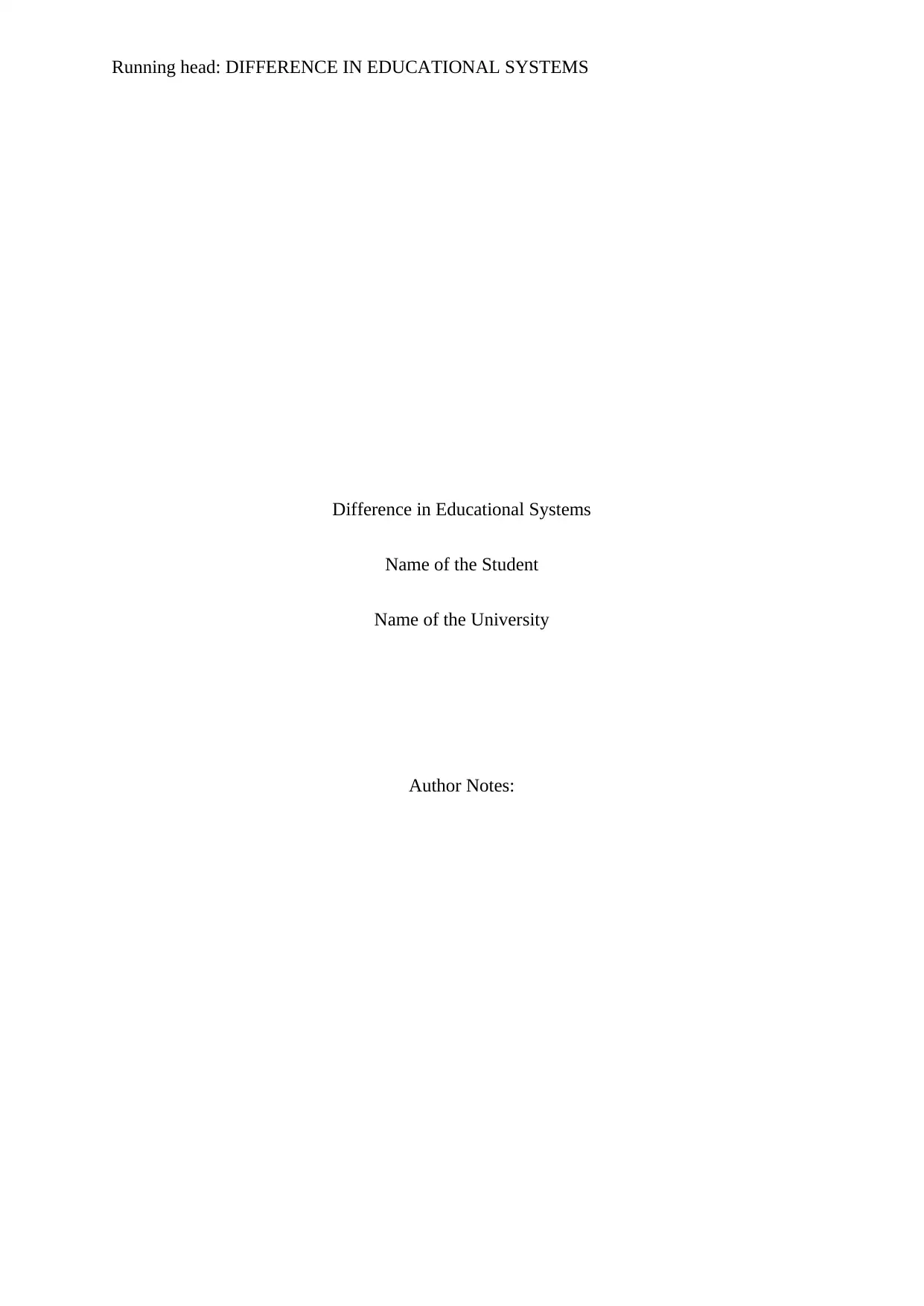
Running head: DIFFERENCE IN EDUCATIONAL SYSTEMS
Difference in Educational Systems
Name of the Student
Name of the University
Author Notes:
Difference in Educational Systems
Name of the Student
Name of the University
Author Notes:
Paraphrase This Document
Need a fresh take? Get an instant paraphrase of this document with our AI Paraphraser
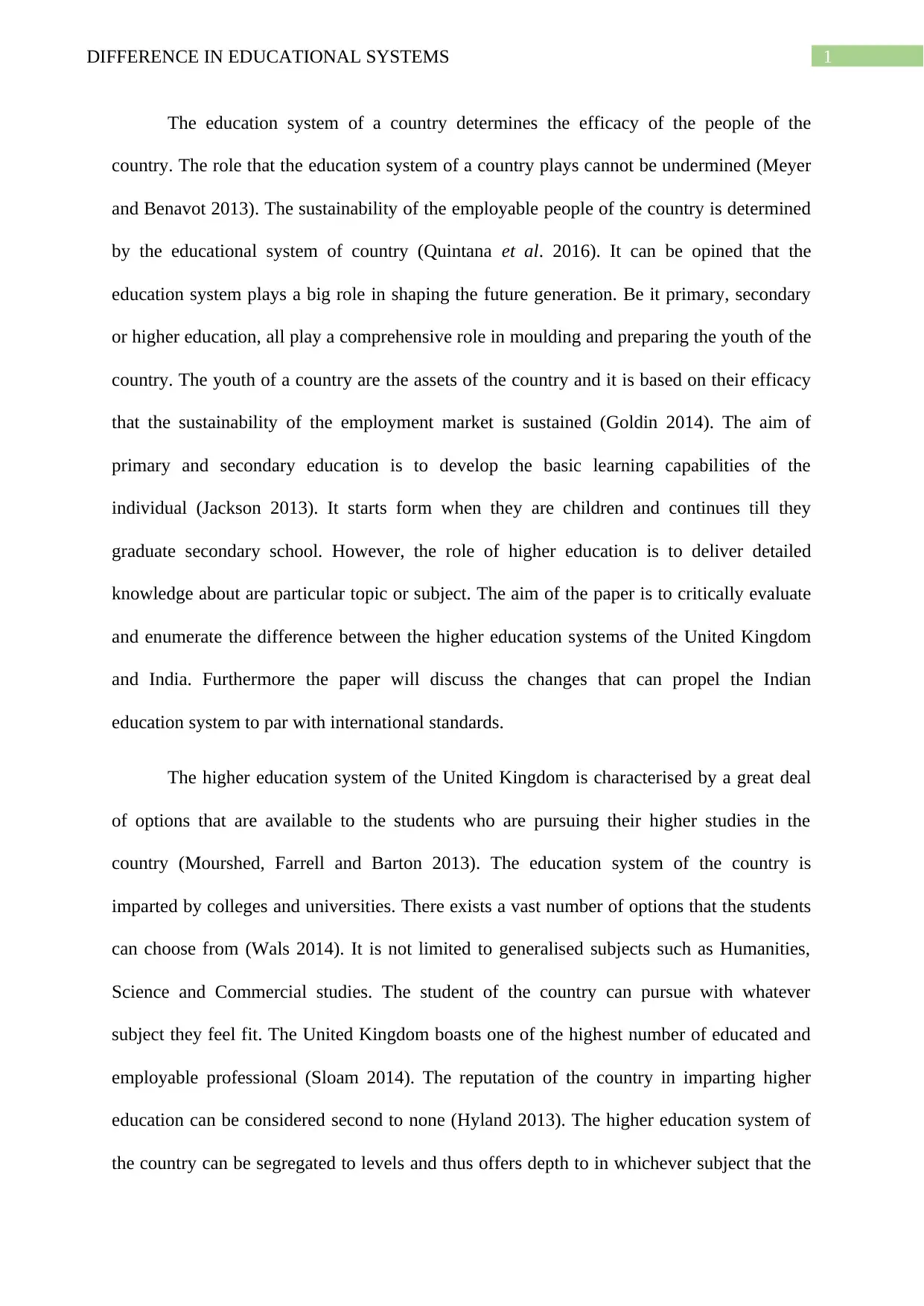
1DIFFERENCE IN EDUCATIONAL SYSTEMS
The education system of a country determines the efficacy of the people of the
country. The role that the education system of a country plays cannot be undermined (Meyer
and Benavot 2013). The sustainability of the employable people of the country is determined
by the educational system of country (Quintana et al. 2016). It can be opined that the
education system plays a big role in shaping the future generation. Be it primary, secondary
or higher education, all play a comprehensive role in moulding and preparing the youth of the
country. The youth of a country are the assets of the country and it is based on their efficacy
that the sustainability of the employment market is sustained (Goldin 2014). The aim of
primary and secondary education is to develop the basic learning capabilities of the
individual (Jackson 2013). It starts form when they are children and continues till they
graduate secondary school. However, the role of higher education is to deliver detailed
knowledge about are particular topic or subject. The aim of the paper is to critically evaluate
and enumerate the difference between the higher education systems of the United Kingdom
and India. Furthermore the paper will discuss the changes that can propel the Indian
education system to par with international standards.
The higher education system of the United Kingdom is characterised by a great deal
of options that are available to the students who are pursuing their higher studies in the
country (Mourshed, Farrell and Barton 2013). The education system of the country is
imparted by colleges and universities. There exists a vast number of options that the students
can choose from (Wals 2014). It is not limited to generalised subjects such as Humanities,
Science and Commercial studies. The student of the country can pursue with whatever
subject they feel fit. The United Kingdom boasts one of the highest number of educated and
employable professional (Sloam 2014). The reputation of the country in imparting higher
education can be considered second to none (Hyland 2013). The higher education system of
the country can be segregated to levels and thus offers depth to in whichever subject that the
The education system of a country determines the efficacy of the people of the
country. The role that the education system of a country plays cannot be undermined (Meyer
and Benavot 2013). The sustainability of the employable people of the country is determined
by the educational system of country (Quintana et al. 2016). It can be opined that the
education system plays a big role in shaping the future generation. Be it primary, secondary
or higher education, all play a comprehensive role in moulding and preparing the youth of the
country. The youth of a country are the assets of the country and it is based on their efficacy
that the sustainability of the employment market is sustained (Goldin 2014). The aim of
primary and secondary education is to develop the basic learning capabilities of the
individual (Jackson 2013). It starts form when they are children and continues till they
graduate secondary school. However, the role of higher education is to deliver detailed
knowledge about are particular topic or subject. The aim of the paper is to critically evaluate
and enumerate the difference between the higher education systems of the United Kingdom
and India. Furthermore the paper will discuss the changes that can propel the Indian
education system to par with international standards.
The higher education system of the United Kingdom is characterised by a great deal
of options that are available to the students who are pursuing their higher studies in the
country (Mourshed, Farrell and Barton 2013). The education system of the country is
imparted by colleges and universities. There exists a vast number of options that the students
can choose from (Wals 2014). It is not limited to generalised subjects such as Humanities,
Science and Commercial studies. The student of the country can pursue with whatever
subject they feel fit. The United Kingdom boasts one of the highest number of educated and
employable professional (Sloam 2014). The reputation of the country in imparting higher
education can be considered second to none (Hyland 2013). The higher education system of
the country can be segregated to levels and thus offers depth to in whichever subject that the
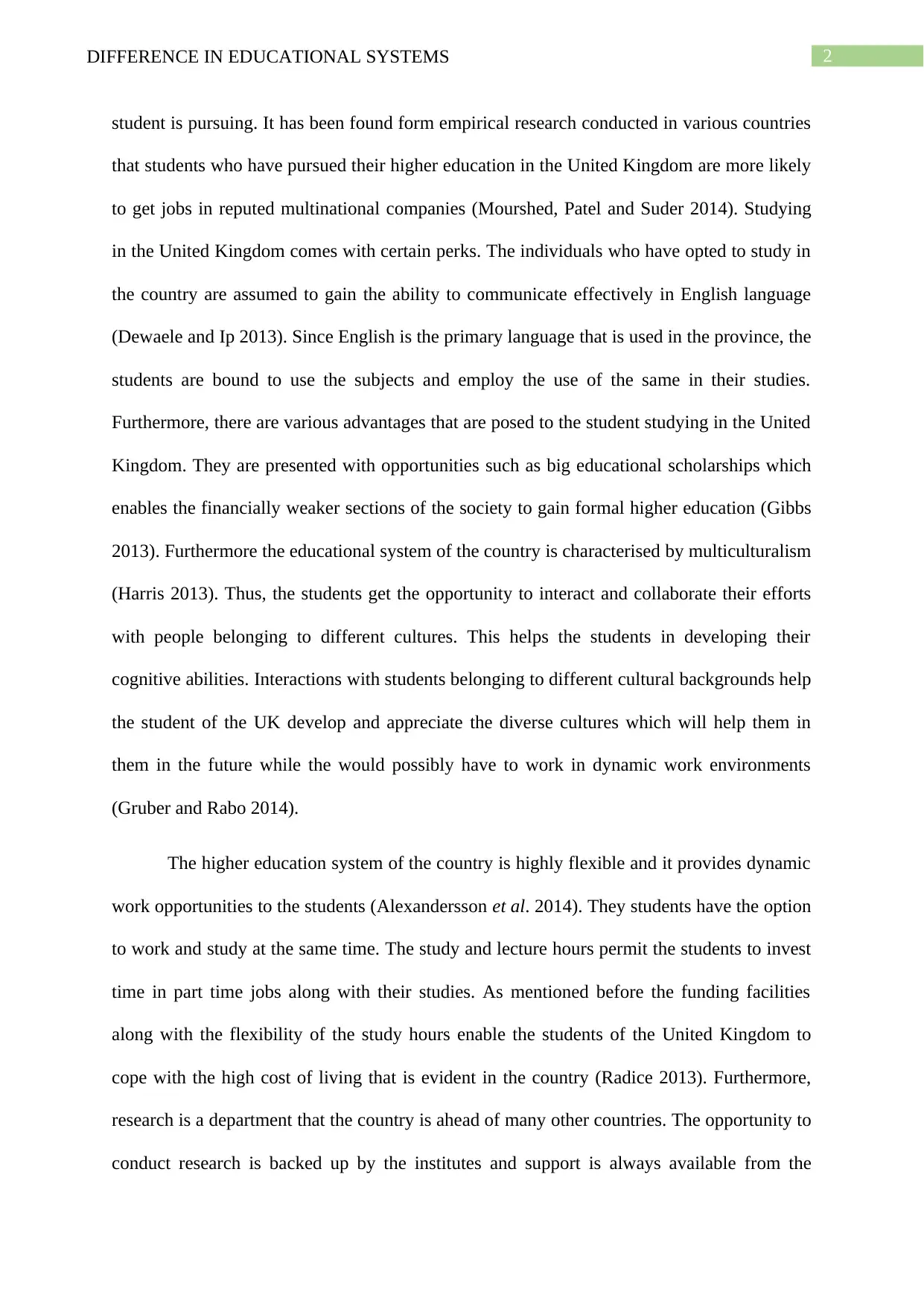
2DIFFERENCE IN EDUCATIONAL SYSTEMS
student is pursuing. It has been found form empirical research conducted in various countries
that students who have pursued their higher education in the United Kingdom are more likely
to get jobs in reputed multinational companies (Mourshed, Patel and Suder 2014). Studying
in the United Kingdom comes with certain perks. The individuals who have opted to study in
the country are assumed to gain the ability to communicate effectively in English language
(Dewaele and Ip 2013). Since English is the primary language that is used in the province, the
students are bound to use the subjects and employ the use of the same in their studies.
Furthermore, there are various advantages that are posed to the student studying in the United
Kingdom. They are presented with opportunities such as big educational scholarships which
enables the financially weaker sections of the society to gain formal higher education (Gibbs
2013). Furthermore the educational system of the country is characterised by multiculturalism
(Harris 2013). Thus, the students get the opportunity to interact and collaborate their efforts
with people belonging to different cultures. This helps the students in developing their
cognitive abilities. Interactions with students belonging to different cultural backgrounds help
the student of the UK develop and appreciate the diverse cultures which will help them in
them in the future while the would possibly have to work in dynamic work environments
(Gruber and Rabo 2014).
The higher education system of the country is highly flexible and it provides dynamic
work opportunities to the students (Alexandersson et al. 2014). They students have the option
to work and study at the same time. The study and lecture hours permit the students to invest
time in part time jobs along with their studies. As mentioned before the funding facilities
along with the flexibility of the study hours enable the students of the United Kingdom to
cope with the high cost of living that is evident in the country (Radice 2013). Furthermore,
research is a department that the country is ahead of many other countries. The opportunity to
conduct research is backed up by the institutes and support is always available from the
student is pursuing. It has been found form empirical research conducted in various countries
that students who have pursued their higher education in the United Kingdom are more likely
to get jobs in reputed multinational companies (Mourshed, Patel and Suder 2014). Studying
in the United Kingdom comes with certain perks. The individuals who have opted to study in
the country are assumed to gain the ability to communicate effectively in English language
(Dewaele and Ip 2013). Since English is the primary language that is used in the province, the
students are bound to use the subjects and employ the use of the same in their studies.
Furthermore, there are various advantages that are posed to the student studying in the United
Kingdom. They are presented with opportunities such as big educational scholarships which
enables the financially weaker sections of the society to gain formal higher education (Gibbs
2013). Furthermore the educational system of the country is characterised by multiculturalism
(Harris 2013). Thus, the students get the opportunity to interact and collaborate their efforts
with people belonging to different cultures. This helps the students in developing their
cognitive abilities. Interactions with students belonging to different cultural backgrounds help
the student of the UK develop and appreciate the diverse cultures which will help them in
them in the future while the would possibly have to work in dynamic work environments
(Gruber and Rabo 2014).
The higher education system of the country is highly flexible and it provides dynamic
work opportunities to the students (Alexandersson et al. 2014). They students have the option
to work and study at the same time. The study and lecture hours permit the students to invest
time in part time jobs along with their studies. As mentioned before the funding facilities
along with the flexibility of the study hours enable the students of the United Kingdom to
cope with the high cost of living that is evident in the country (Radice 2013). Furthermore,
research is a department that the country is ahead of many other countries. The opportunity to
conduct research is backed up by the institutes and support is always available from the
⊘ This is a preview!⊘
Do you want full access?
Subscribe today to unlock all pages.

Trusted by 1+ million students worldwide
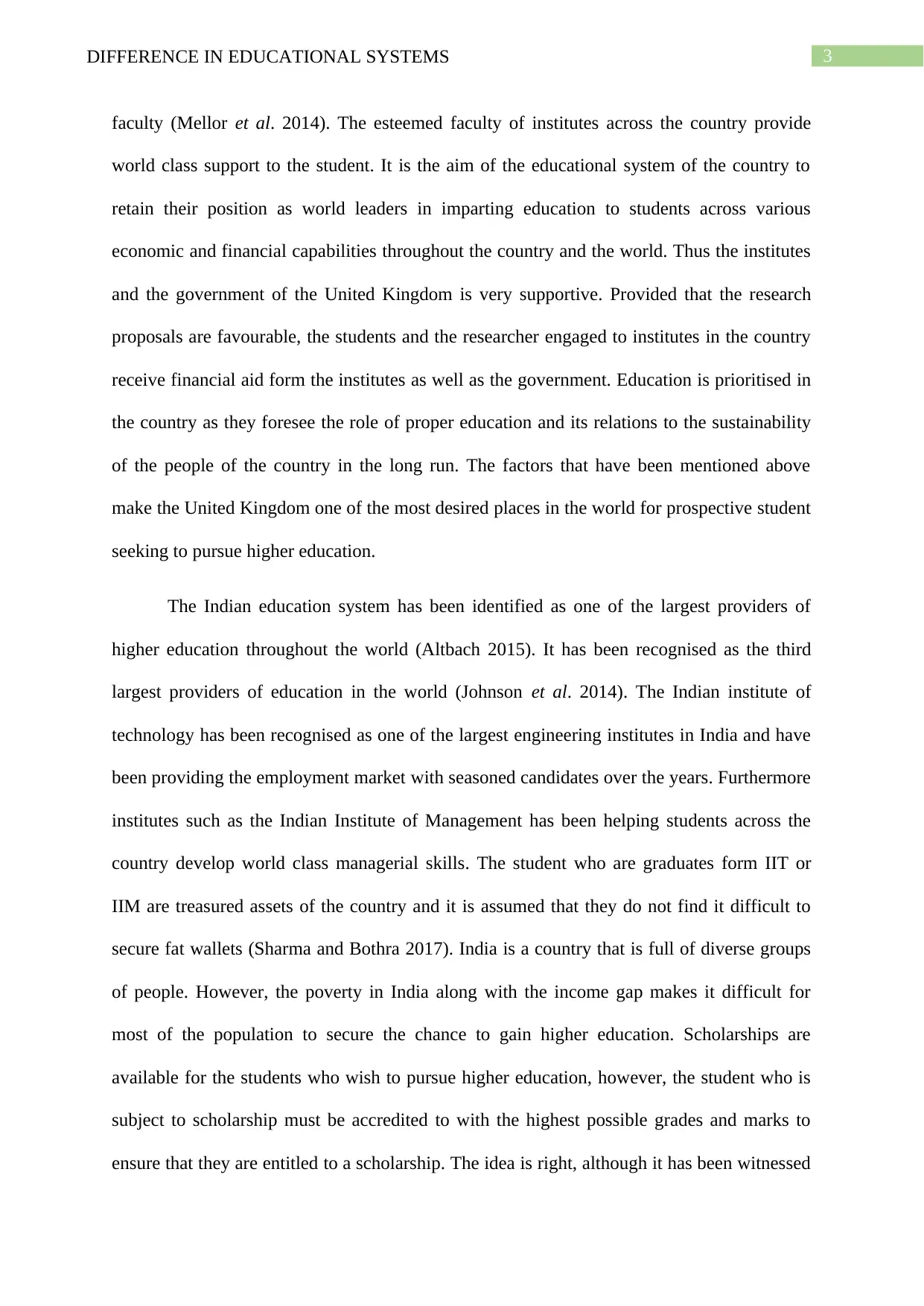
3DIFFERENCE IN EDUCATIONAL SYSTEMS
faculty (Mellor et al. 2014). The esteemed faculty of institutes across the country provide
world class support to the student. It is the aim of the educational system of the country to
retain their position as world leaders in imparting education to students across various
economic and financial capabilities throughout the country and the world. Thus the institutes
and the government of the United Kingdom is very supportive. Provided that the research
proposals are favourable, the students and the researcher engaged to institutes in the country
receive financial aid form the institutes as well as the government. Education is prioritised in
the country as they foresee the role of proper education and its relations to the sustainability
of the people of the country in the long run. The factors that have been mentioned above
make the United Kingdom one of the most desired places in the world for prospective student
seeking to pursue higher education.
The Indian education system has been identified as one of the largest providers of
higher education throughout the world (Altbach 2015). It has been recognised as the third
largest providers of education in the world (Johnson et al. 2014). The Indian institute of
technology has been recognised as one of the largest engineering institutes in India and have
been providing the employment market with seasoned candidates over the years. Furthermore
institutes such as the Indian Institute of Management has been helping students across the
country develop world class managerial skills. The student who are graduates form IIT or
IIM are treasured assets of the country and it is assumed that they do not find it difficult to
secure fat wallets (Sharma and Bothra 2017). India is a country that is full of diverse groups
of people. However, the poverty in India along with the income gap makes it difficult for
most of the population to secure the chance to gain higher education. Scholarships are
available for the students who wish to pursue higher education, however, the student who is
subject to scholarship must be accredited to with the highest possible grades and marks to
ensure that they are entitled to a scholarship. The idea is right, although it has been witnessed
faculty (Mellor et al. 2014). The esteemed faculty of institutes across the country provide
world class support to the student. It is the aim of the educational system of the country to
retain their position as world leaders in imparting education to students across various
economic and financial capabilities throughout the country and the world. Thus the institutes
and the government of the United Kingdom is very supportive. Provided that the research
proposals are favourable, the students and the researcher engaged to institutes in the country
receive financial aid form the institutes as well as the government. Education is prioritised in
the country as they foresee the role of proper education and its relations to the sustainability
of the people of the country in the long run. The factors that have been mentioned above
make the United Kingdom one of the most desired places in the world for prospective student
seeking to pursue higher education.
The Indian education system has been identified as one of the largest providers of
higher education throughout the world (Altbach 2015). It has been recognised as the third
largest providers of education in the world (Johnson et al. 2014). The Indian institute of
technology has been recognised as one of the largest engineering institutes in India and have
been providing the employment market with seasoned candidates over the years. Furthermore
institutes such as the Indian Institute of Management has been helping students across the
country develop world class managerial skills. The student who are graduates form IIT or
IIM are treasured assets of the country and it is assumed that they do not find it difficult to
secure fat wallets (Sharma and Bothra 2017). India is a country that is full of diverse groups
of people. However, the poverty in India along with the income gap makes it difficult for
most of the population to secure the chance to gain higher education. Scholarships are
available for the students who wish to pursue higher education, however, the student who is
subject to scholarship must be accredited to with the highest possible grades and marks to
ensure that they are entitled to a scholarship. The idea is right, although it has been witnessed
Paraphrase This Document
Need a fresh take? Get an instant paraphrase of this document with our AI Paraphraser
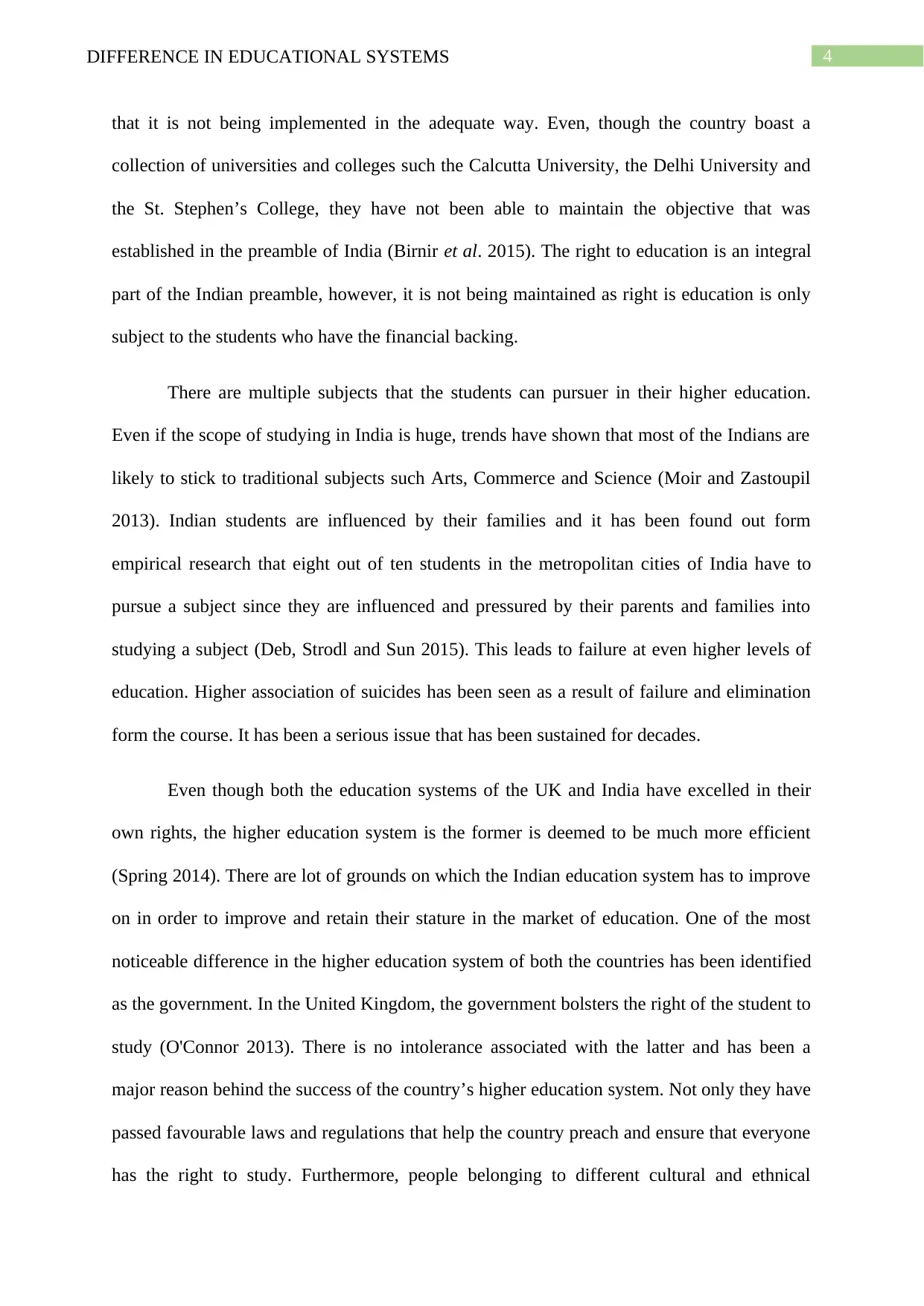
4DIFFERENCE IN EDUCATIONAL SYSTEMS
that it is not being implemented in the adequate way. Even, though the country boast a
collection of universities and colleges such the Calcutta University, the Delhi University and
the St. Stephen’s College, they have not been able to maintain the objective that was
established in the preamble of India (Birnir et al. 2015). The right to education is an integral
part of the Indian preamble, however, it is not being maintained as right is education is only
subject to the students who have the financial backing.
There are multiple subjects that the students can pursuer in their higher education.
Even if the scope of studying in India is huge, trends have shown that most of the Indians are
likely to stick to traditional subjects such Arts, Commerce and Science (Moir and Zastoupil
2013). Indian students are influenced by their families and it has been found out form
empirical research that eight out of ten students in the metropolitan cities of India have to
pursue a subject since they are influenced and pressured by their parents and families into
studying a subject (Deb, Strodl and Sun 2015). This leads to failure at even higher levels of
education. Higher association of suicides has been seen as a result of failure and elimination
form the course. It has been a serious issue that has been sustained for decades.
Even though both the education systems of the UK and India have excelled in their
own rights, the higher education system is the former is deemed to be much more efficient
(Spring 2014). There are lot of grounds on which the Indian education system has to improve
on in order to improve and retain their stature in the market of education. One of the most
noticeable difference in the higher education system of both the countries has been identified
as the government. In the United Kingdom, the government bolsters the right of the student to
study (O'Connor 2013). There is no intolerance associated with the latter and has been a
major reason behind the success of the country’s higher education system. Not only they have
passed favourable laws and regulations that help the country preach and ensure that everyone
has the right to study. Furthermore, people belonging to different cultural and ethnical
that it is not being implemented in the adequate way. Even, though the country boast a
collection of universities and colleges such the Calcutta University, the Delhi University and
the St. Stephen’s College, they have not been able to maintain the objective that was
established in the preamble of India (Birnir et al. 2015). The right to education is an integral
part of the Indian preamble, however, it is not being maintained as right is education is only
subject to the students who have the financial backing.
There are multiple subjects that the students can pursuer in their higher education.
Even if the scope of studying in India is huge, trends have shown that most of the Indians are
likely to stick to traditional subjects such Arts, Commerce and Science (Moir and Zastoupil
2013). Indian students are influenced by their families and it has been found out form
empirical research that eight out of ten students in the metropolitan cities of India have to
pursue a subject since they are influenced and pressured by their parents and families into
studying a subject (Deb, Strodl and Sun 2015). This leads to failure at even higher levels of
education. Higher association of suicides has been seen as a result of failure and elimination
form the course. It has been a serious issue that has been sustained for decades.
Even though both the education systems of the UK and India have excelled in their
own rights, the higher education system is the former is deemed to be much more efficient
(Spring 2014). There are lot of grounds on which the Indian education system has to improve
on in order to improve and retain their stature in the market of education. One of the most
noticeable difference in the higher education system of both the countries has been identified
as the government. In the United Kingdom, the government bolsters the right of the student to
study (O'Connor 2013). There is no intolerance associated with the latter and has been a
major reason behind the success of the country’s higher education system. Not only they have
passed favourable laws and regulations that help the country preach and ensure that everyone
has the right to study. Furthermore, people belonging to different cultural and ethnical
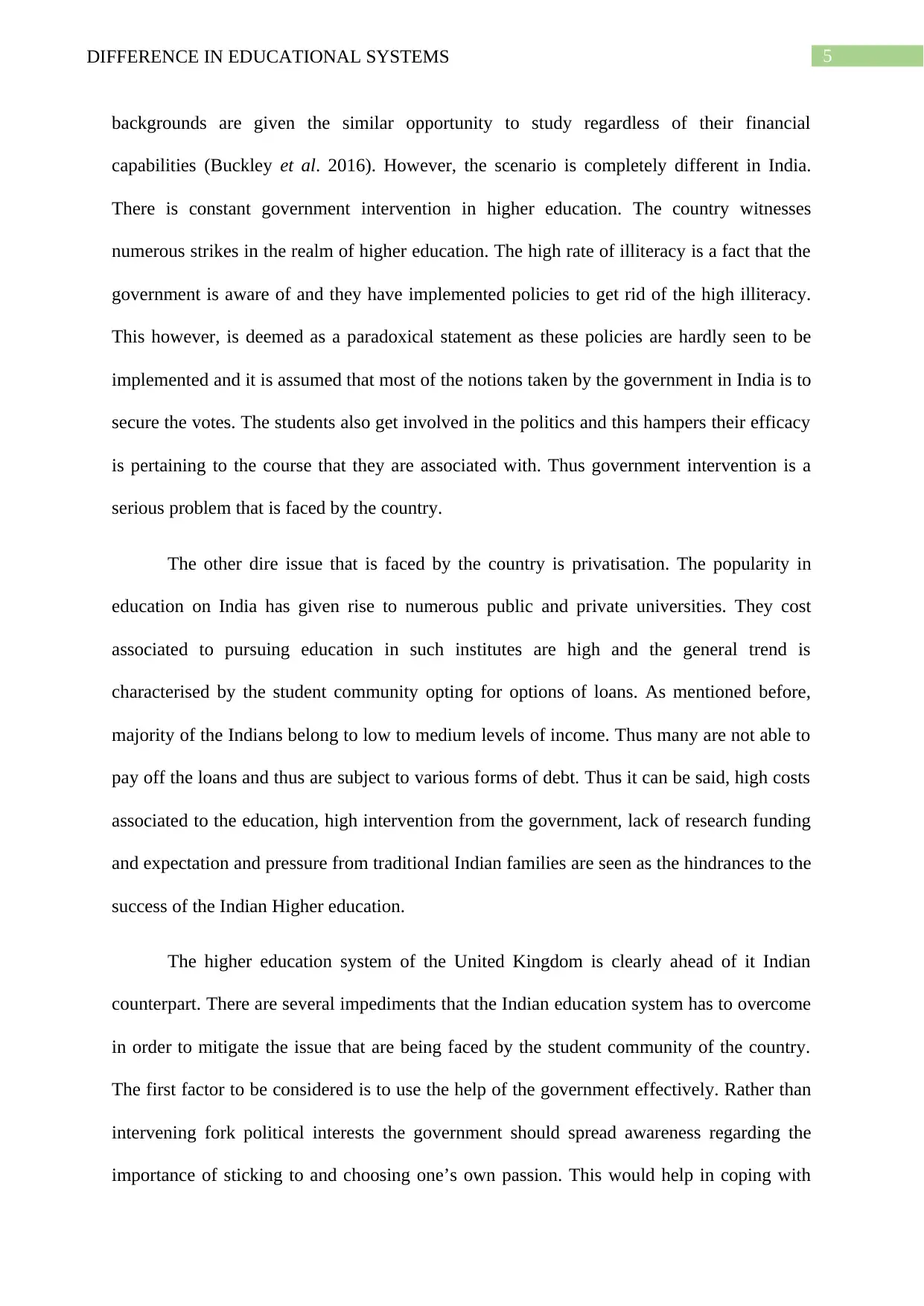
5DIFFERENCE IN EDUCATIONAL SYSTEMS
backgrounds are given the similar opportunity to study regardless of their financial
capabilities (Buckley et al. 2016). However, the scenario is completely different in India.
There is constant government intervention in higher education. The country witnesses
numerous strikes in the realm of higher education. The high rate of illiteracy is a fact that the
government is aware of and they have implemented policies to get rid of the high illiteracy.
This however, is deemed as a paradoxical statement as these policies are hardly seen to be
implemented and it is assumed that most of the notions taken by the government in India is to
secure the votes. The students also get involved in the politics and this hampers their efficacy
is pertaining to the course that they are associated with. Thus government intervention is a
serious problem that is faced by the country.
The other dire issue that is faced by the country is privatisation. The popularity in
education on India has given rise to numerous public and private universities. They cost
associated to pursuing education in such institutes are high and the general trend is
characterised by the student community opting for options of loans. As mentioned before,
majority of the Indians belong to low to medium levels of income. Thus many are not able to
pay off the loans and thus are subject to various forms of debt. Thus it can be said, high costs
associated to the education, high intervention from the government, lack of research funding
and expectation and pressure from traditional Indian families are seen as the hindrances to the
success of the Indian Higher education.
The higher education system of the United Kingdom is clearly ahead of it Indian
counterpart. There are several impediments that the Indian education system has to overcome
in order to mitigate the issue that are being faced by the student community of the country.
The first factor to be considered is to use the help of the government effectively. Rather than
intervening fork political interests the government should spread awareness regarding the
importance of sticking to and choosing one’s own passion. This would help in coping with
backgrounds are given the similar opportunity to study regardless of their financial
capabilities (Buckley et al. 2016). However, the scenario is completely different in India.
There is constant government intervention in higher education. The country witnesses
numerous strikes in the realm of higher education. The high rate of illiteracy is a fact that the
government is aware of and they have implemented policies to get rid of the high illiteracy.
This however, is deemed as a paradoxical statement as these policies are hardly seen to be
implemented and it is assumed that most of the notions taken by the government in India is to
secure the votes. The students also get involved in the politics and this hampers their efficacy
is pertaining to the course that they are associated with. Thus government intervention is a
serious problem that is faced by the country.
The other dire issue that is faced by the country is privatisation. The popularity in
education on India has given rise to numerous public and private universities. They cost
associated to pursuing education in such institutes are high and the general trend is
characterised by the student community opting for options of loans. As mentioned before,
majority of the Indians belong to low to medium levels of income. Thus many are not able to
pay off the loans and thus are subject to various forms of debt. Thus it can be said, high costs
associated to the education, high intervention from the government, lack of research funding
and expectation and pressure from traditional Indian families are seen as the hindrances to the
success of the Indian Higher education.
The higher education system of the United Kingdom is clearly ahead of it Indian
counterpart. There are several impediments that the Indian education system has to overcome
in order to mitigate the issue that are being faced by the student community of the country.
The first factor to be considered is to use the help of the government effectively. Rather than
intervening fork political interests the government should spread awareness regarding the
importance of sticking to and choosing one’s own passion. This would help in coping with
⊘ This is a preview!⊘
Do you want full access?
Subscribe today to unlock all pages.

Trusted by 1+ million students worldwide
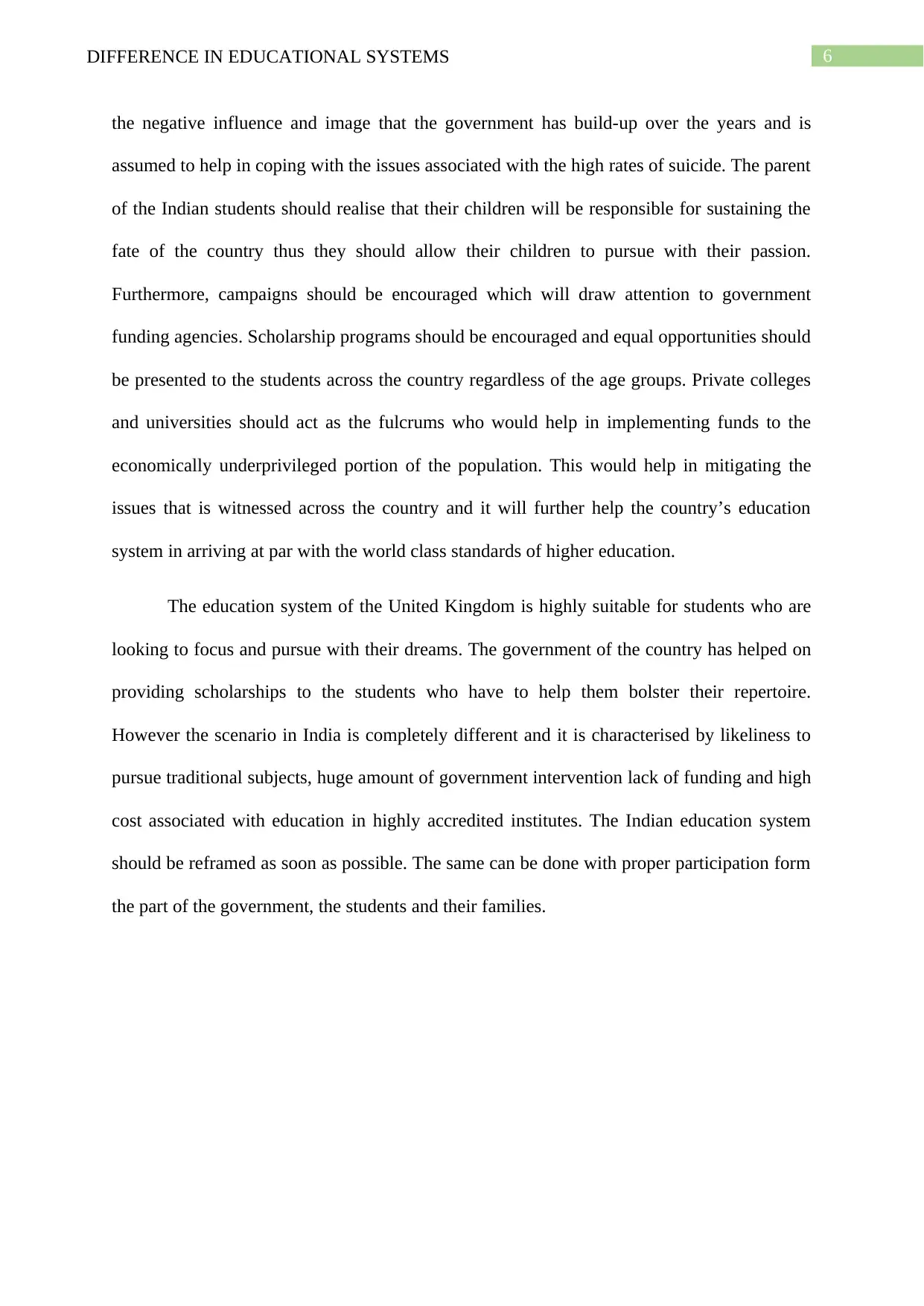
6DIFFERENCE IN EDUCATIONAL SYSTEMS
the negative influence and image that the government has build-up over the years and is
assumed to help in coping with the issues associated with the high rates of suicide. The parent
of the Indian students should realise that their children will be responsible for sustaining the
fate of the country thus they should allow their children to pursue with their passion.
Furthermore, campaigns should be encouraged which will draw attention to government
funding agencies. Scholarship programs should be encouraged and equal opportunities should
be presented to the students across the country regardless of the age groups. Private colleges
and universities should act as the fulcrums who would help in implementing funds to the
economically underprivileged portion of the population. This would help in mitigating the
issues that is witnessed across the country and it will further help the country’s education
system in arriving at par with the world class standards of higher education.
The education system of the United Kingdom is highly suitable for students who are
looking to focus and pursue with their dreams. The government of the country has helped on
providing scholarships to the students who have to help them bolster their repertoire.
However the scenario in India is completely different and it is characterised by likeliness to
pursue traditional subjects, huge amount of government intervention lack of funding and high
cost associated with education in highly accredited institutes. The Indian education system
should be reframed as soon as possible. The same can be done with proper participation form
the part of the government, the students and their families.
the negative influence and image that the government has build-up over the years and is
assumed to help in coping with the issues associated with the high rates of suicide. The parent
of the Indian students should realise that their children will be responsible for sustaining the
fate of the country thus they should allow their children to pursue with their passion.
Furthermore, campaigns should be encouraged which will draw attention to government
funding agencies. Scholarship programs should be encouraged and equal opportunities should
be presented to the students across the country regardless of the age groups. Private colleges
and universities should act as the fulcrums who would help in implementing funds to the
economically underprivileged portion of the population. This would help in mitigating the
issues that is witnessed across the country and it will further help the country’s education
system in arriving at par with the world class standards of higher education.
The education system of the United Kingdom is highly suitable for students who are
looking to focus and pursue with their dreams. The government of the country has helped on
providing scholarships to the students who have to help them bolster their repertoire.
However the scenario in India is completely different and it is characterised by likeliness to
pursue traditional subjects, huge amount of government intervention lack of funding and high
cost associated with education in highly accredited institutes. The Indian education system
should be reframed as soon as possible. The same can be done with proper participation form
the part of the government, the students and their families.
Paraphrase This Document
Need a fresh take? Get an instant paraphrase of this document with our AI Paraphraser
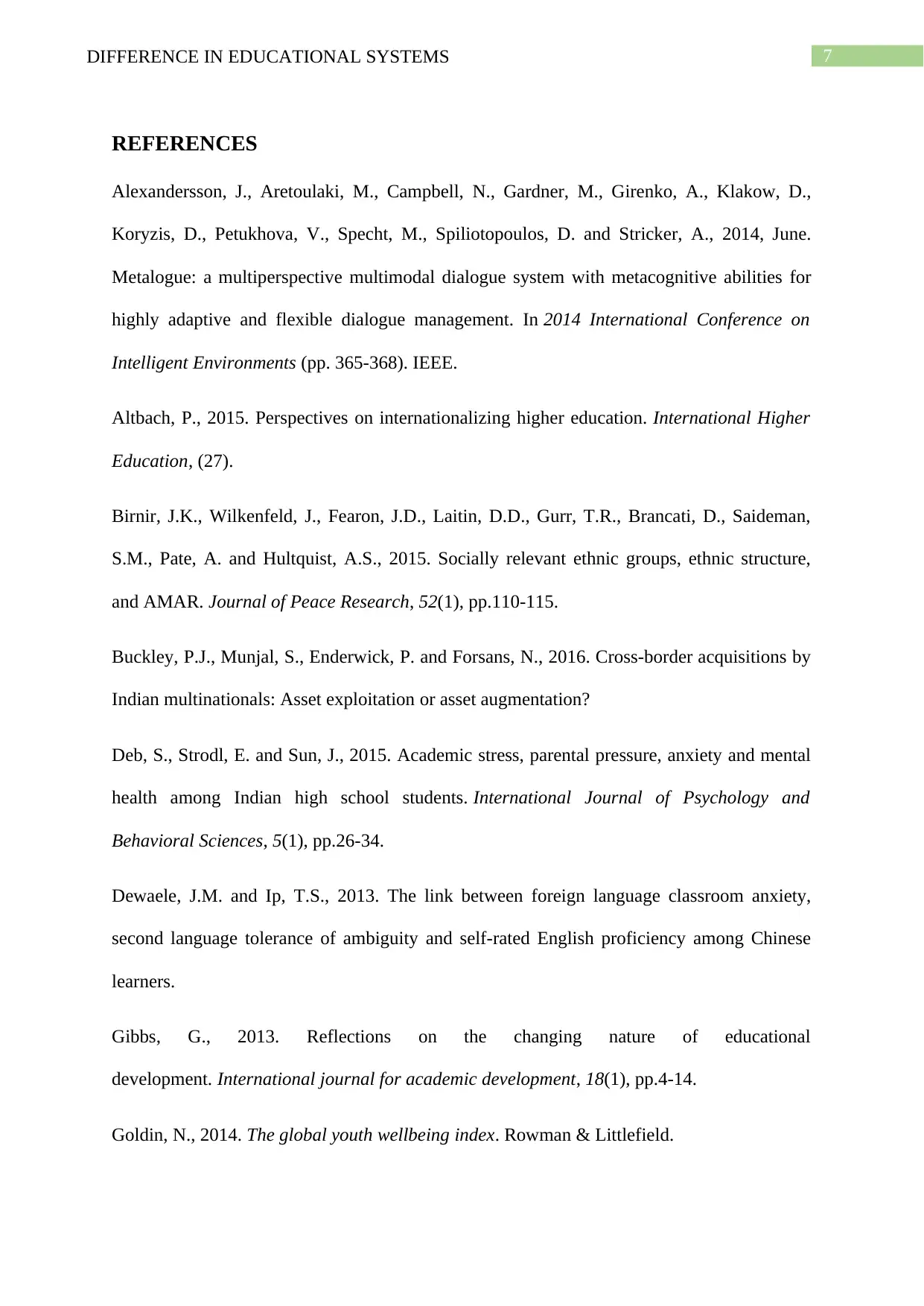
7DIFFERENCE IN EDUCATIONAL SYSTEMS
REFERENCES
Alexandersson, J., Aretoulaki, M., Campbell, N., Gardner, M., Girenko, A., Klakow, D.,
Koryzis, D., Petukhova, V., Specht, M., Spiliotopoulos, D. and Stricker, A., 2014, June.
Metalogue: a multiperspective multimodal dialogue system with metacognitive abilities for
highly adaptive and flexible dialogue management. In 2014 International Conference on
Intelligent Environments (pp. 365-368). IEEE.
Altbach, P., 2015. Perspectives on internationalizing higher education. International Higher
Education, (27).
Birnir, J.K., Wilkenfeld, J., Fearon, J.D., Laitin, D.D., Gurr, T.R., Brancati, D., Saideman,
S.M., Pate, A. and Hultquist, A.S., 2015. Socially relevant ethnic groups, ethnic structure,
and AMAR. Journal of Peace Research, 52(1), pp.110-115.
Buckley, P.J., Munjal, S., Enderwick, P. and Forsans, N., 2016. Cross-border acquisitions by
Indian multinationals: Asset exploitation or asset augmentation?
Deb, S., Strodl, E. and Sun, J., 2015. Academic stress, parental pressure, anxiety and mental
health among Indian high school students. International Journal of Psychology and
Behavioral Sciences, 5(1), pp.26-34.
Dewaele, J.M. and Ip, T.S., 2013. The link between foreign language classroom anxiety,
second language tolerance of ambiguity and self-rated English proficiency among Chinese
learners.
Gibbs, G., 2013. Reflections on the changing nature of educational
development. International journal for academic development, 18(1), pp.4-14.
Goldin, N., 2014. The global youth wellbeing index. Rowman & Littlefield.
REFERENCES
Alexandersson, J., Aretoulaki, M., Campbell, N., Gardner, M., Girenko, A., Klakow, D.,
Koryzis, D., Petukhova, V., Specht, M., Spiliotopoulos, D. and Stricker, A., 2014, June.
Metalogue: a multiperspective multimodal dialogue system with metacognitive abilities for
highly adaptive and flexible dialogue management. In 2014 International Conference on
Intelligent Environments (pp. 365-368). IEEE.
Altbach, P., 2015. Perspectives on internationalizing higher education. International Higher
Education, (27).
Birnir, J.K., Wilkenfeld, J., Fearon, J.D., Laitin, D.D., Gurr, T.R., Brancati, D., Saideman,
S.M., Pate, A. and Hultquist, A.S., 2015. Socially relevant ethnic groups, ethnic structure,
and AMAR. Journal of Peace Research, 52(1), pp.110-115.
Buckley, P.J., Munjal, S., Enderwick, P. and Forsans, N., 2016. Cross-border acquisitions by
Indian multinationals: Asset exploitation or asset augmentation?
Deb, S., Strodl, E. and Sun, J., 2015. Academic stress, parental pressure, anxiety and mental
health among Indian high school students. International Journal of Psychology and
Behavioral Sciences, 5(1), pp.26-34.
Dewaele, J.M. and Ip, T.S., 2013. The link between foreign language classroom anxiety,
second language tolerance of ambiguity and self-rated English proficiency among Chinese
learners.
Gibbs, G., 2013. Reflections on the changing nature of educational
development. International journal for academic development, 18(1), pp.4-14.
Goldin, N., 2014. The global youth wellbeing index. Rowman & Littlefield.
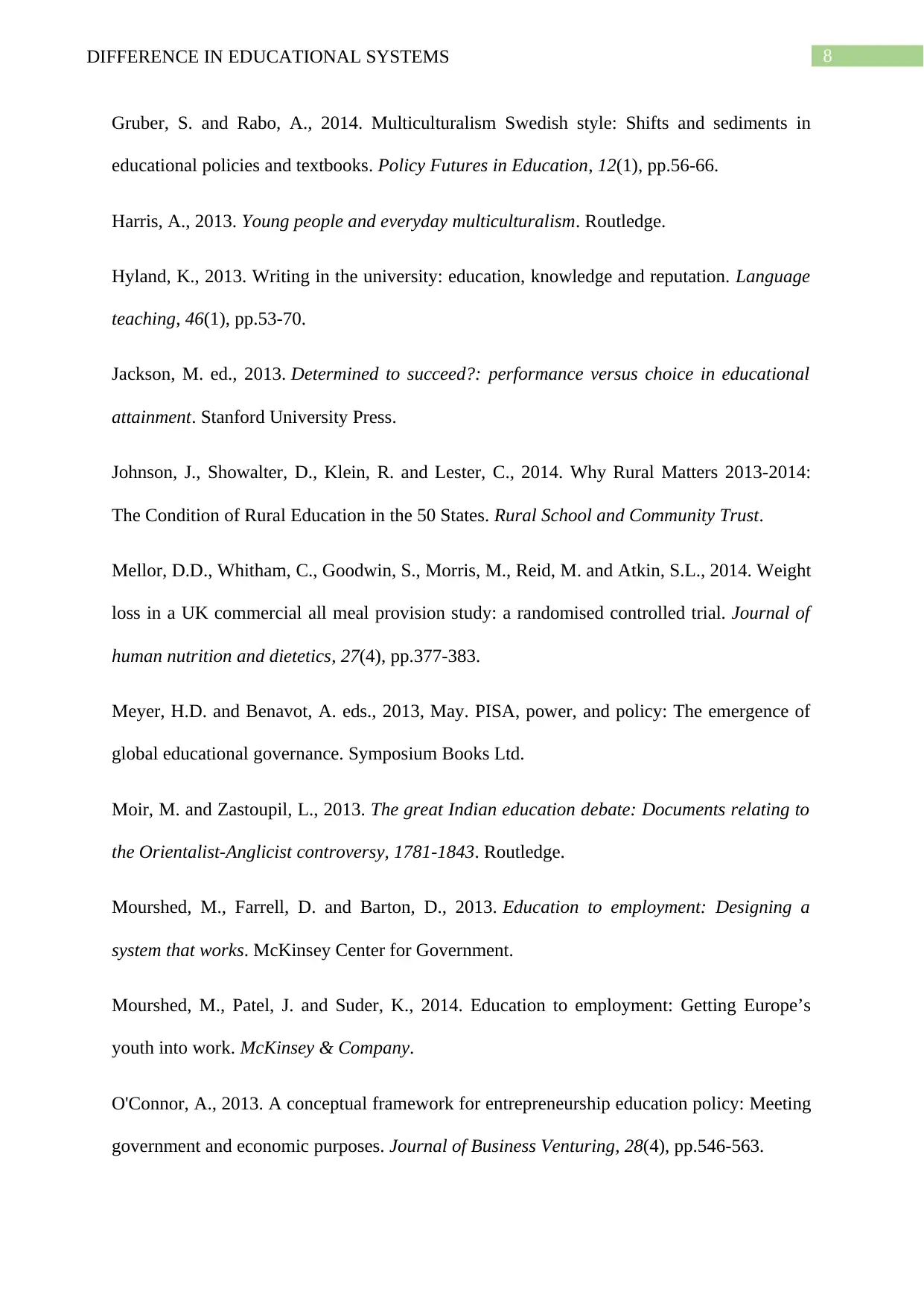
8DIFFERENCE IN EDUCATIONAL SYSTEMS
Gruber, S. and Rabo, A., 2014. Multiculturalism Swedish style: Shifts and sediments in
educational policies and textbooks. Policy Futures in Education, 12(1), pp.56-66.
Harris, A., 2013. Young people and everyday multiculturalism. Routledge.
Hyland, K., 2013. Writing in the university: education, knowledge and reputation. Language
teaching, 46(1), pp.53-70.
Jackson, M. ed., 2013. Determined to succeed?: performance versus choice in educational
attainment. Stanford University Press.
Johnson, J., Showalter, D., Klein, R. and Lester, C., 2014. Why Rural Matters 2013-2014:
The Condition of Rural Education in the 50 States. Rural School and Community Trust.
Mellor, D.D., Whitham, C., Goodwin, S., Morris, M., Reid, M. and Atkin, S.L., 2014. Weight
loss in a UK commercial all meal provision study: a randomised controlled trial. Journal of
human nutrition and dietetics, 27(4), pp.377-383.
Meyer, H.D. and Benavot, A. eds., 2013, May. PISA, power, and policy: The emergence of
global educational governance. Symposium Books Ltd.
Moir, M. and Zastoupil, L., 2013. The great Indian education debate: Documents relating to
the Orientalist-Anglicist controversy, 1781-1843. Routledge.
Mourshed, M., Farrell, D. and Barton, D., 2013. Education to employment: Designing a
system that works. McKinsey Center for Government.
Mourshed, M., Patel, J. and Suder, K., 2014. Education to employment: Getting Europe’s
youth into work. McKinsey & Company.
O'Connor, A., 2013. A conceptual framework for entrepreneurship education policy: Meeting
government and economic purposes. Journal of Business Venturing, 28(4), pp.546-563.
Gruber, S. and Rabo, A., 2014. Multiculturalism Swedish style: Shifts and sediments in
educational policies and textbooks. Policy Futures in Education, 12(1), pp.56-66.
Harris, A., 2013. Young people and everyday multiculturalism. Routledge.
Hyland, K., 2013. Writing in the university: education, knowledge and reputation. Language
teaching, 46(1), pp.53-70.
Jackson, M. ed., 2013. Determined to succeed?: performance versus choice in educational
attainment. Stanford University Press.
Johnson, J., Showalter, D., Klein, R. and Lester, C., 2014. Why Rural Matters 2013-2014:
The Condition of Rural Education in the 50 States. Rural School and Community Trust.
Mellor, D.D., Whitham, C., Goodwin, S., Morris, M., Reid, M. and Atkin, S.L., 2014. Weight
loss in a UK commercial all meal provision study: a randomised controlled trial. Journal of
human nutrition and dietetics, 27(4), pp.377-383.
Meyer, H.D. and Benavot, A. eds., 2013, May. PISA, power, and policy: The emergence of
global educational governance. Symposium Books Ltd.
Moir, M. and Zastoupil, L., 2013. The great Indian education debate: Documents relating to
the Orientalist-Anglicist controversy, 1781-1843. Routledge.
Mourshed, M., Farrell, D. and Barton, D., 2013. Education to employment: Designing a
system that works. McKinsey Center for Government.
Mourshed, M., Patel, J. and Suder, K., 2014. Education to employment: Getting Europe’s
youth into work. McKinsey & Company.
O'Connor, A., 2013. A conceptual framework for entrepreneurship education policy: Meeting
government and economic purposes. Journal of Business Venturing, 28(4), pp.546-563.
⊘ This is a preview!⊘
Do you want full access?
Subscribe today to unlock all pages.

Trusted by 1+ million students worldwide
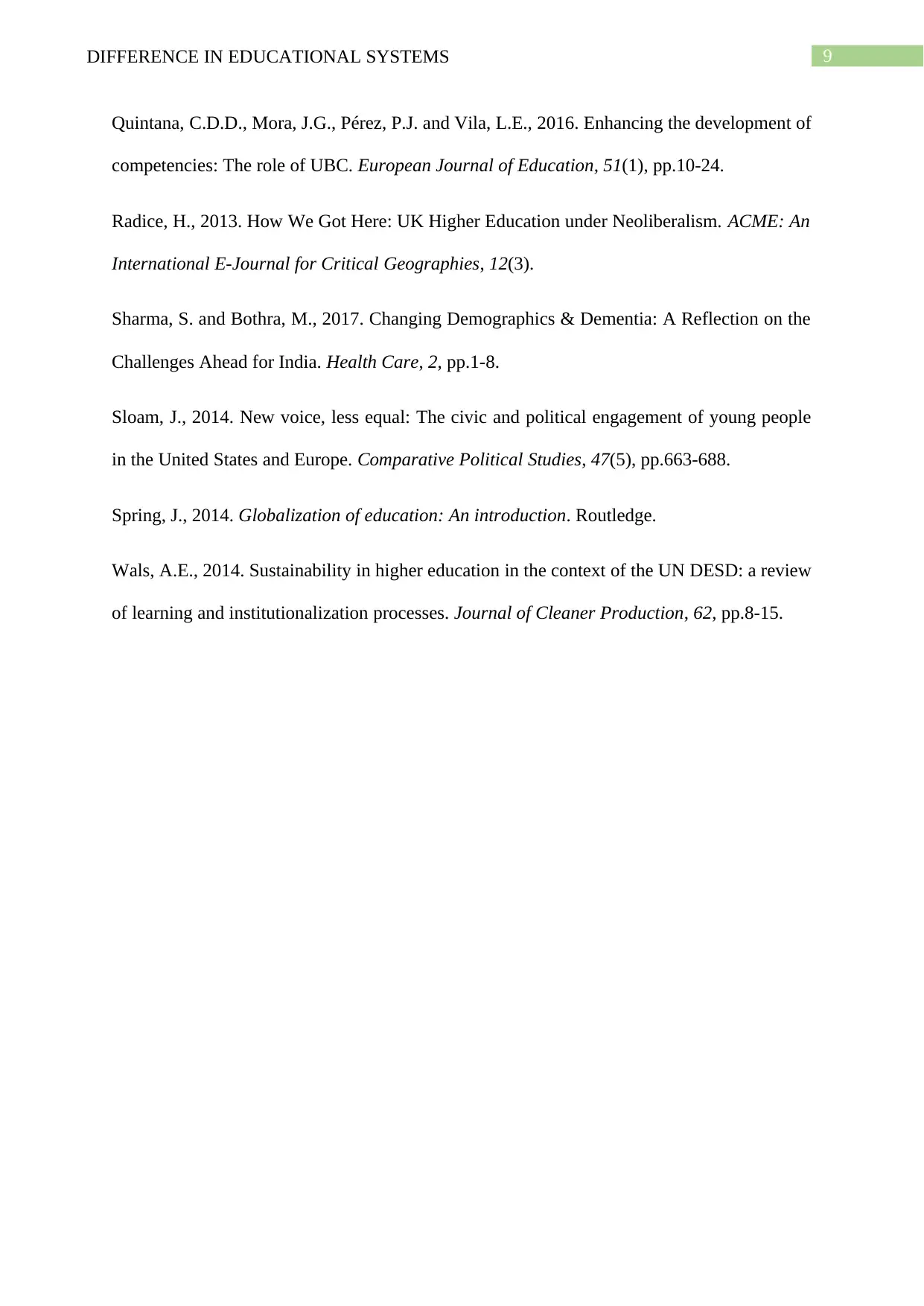
9DIFFERENCE IN EDUCATIONAL SYSTEMS
Quintana, C.D.D., Mora, J.G., Pérez, P.J. and Vila, L.E., 2016. Enhancing the development of
competencies: The role of UBC. European Journal of Education, 51(1), pp.10-24.
Radice, H., 2013. How We Got Here: UK Higher Education under Neoliberalism. ACME: An
International E-Journal for Critical Geographies, 12(3).
Sharma, S. and Bothra, M., 2017. Changing Demographics & Dementia: A Reflection on the
Challenges Ahead for India. Health Care, 2, pp.1-8.
Sloam, J., 2014. New voice, less equal: The civic and political engagement of young people
in the United States and Europe. Comparative Political Studies, 47(5), pp.663-688.
Spring, J., 2014. Globalization of education: An introduction. Routledge.
Wals, A.E., 2014. Sustainability in higher education in the context of the UN DESD: a review
of learning and institutionalization processes. Journal of Cleaner Production, 62, pp.8-15.
Quintana, C.D.D., Mora, J.G., Pérez, P.J. and Vila, L.E., 2016. Enhancing the development of
competencies: The role of UBC. European Journal of Education, 51(1), pp.10-24.
Radice, H., 2013. How We Got Here: UK Higher Education under Neoliberalism. ACME: An
International E-Journal for Critical Geographies, 12(3).
Sharma, S. and Bothra, M., 2017. Changing Demographics & Dementia: A Reflection on the
Challenges Ahead for India. Health Care, 2, pp.1-8.
Sloam, J., 2014. New voice, less equal: The civic and political engagement of young people
in the United States and Europe. Comparative Political Studies, 47(5), pp.663-688.
Spring, J., 2014. Globalization of education: An introduction. Routledge.
Wals, A.E., 2014. Sustainability in higher education in the context of the UN DESD: a review
of learning and institutionalization processes. Journal of Cleaner Production, 62, pp.8-15.
1 out of 10
Related Documents
Your All-in-One AI-Powered Toolkit for Academic Success.
+13062052269
info@desklib.com
Available 24*7 on WhatsApp / Email
![[object Object]](/_next/static/media/star-bottom.7253800d.svg)
Unlock your academic potential
Copyright © 2020–2025 A2Z Services. All Rights Reserved. Developed and managed by ZUCOL.





